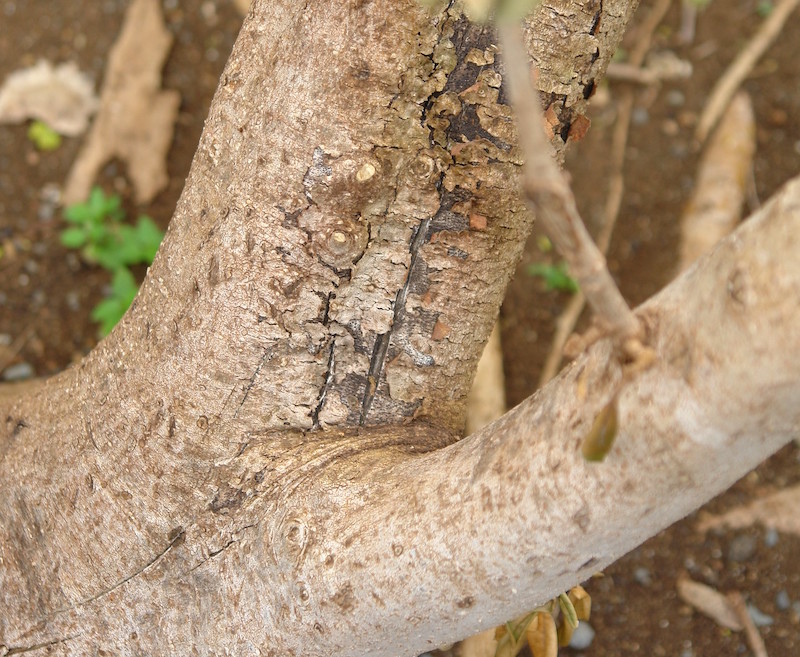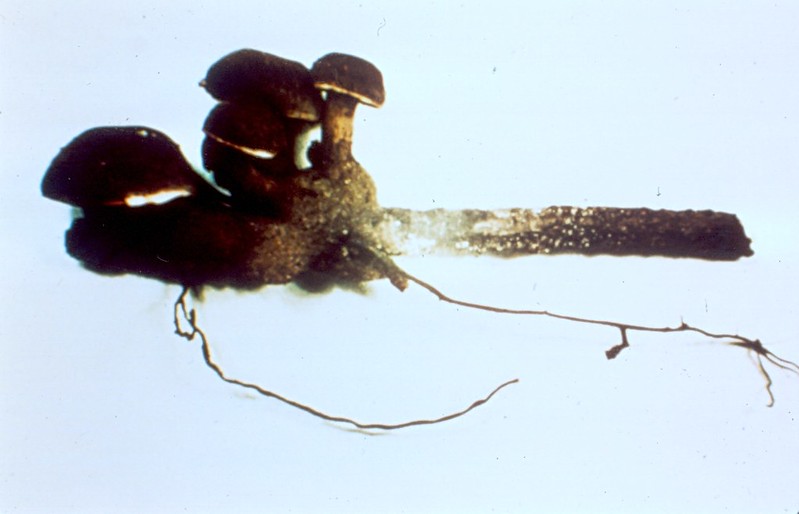Viburnum is a diverse genus of shrubs that are grown for their glossy leaves, showy flowers, and ornamental fruit. While these beloved garden plants are easy to grow, they may occasionally be affected by a variety of diseases caused by fungal pathogens and fungus-like organisms called oomycetes. While most diseases of viburnum are only aesthetic concerns, others - such as root rot and cankers - can be more serious. For all viburnum diseases, prevention is key for healthy shrubs.
Botryosphaeria Canker
Cankers in viburnum are caused by the fungus Botryosphaeria. This pathogen enters through wounds in the bark of the shrub, girdling branches by killing the cambium tissue. This prevents the plant from being able to transport water and nutrients through the infected branches. Leaves will wilt and drop, resulting in dieback of branches. Botryosphaeria canker is more likely to affect viburnums that have been stressed from injury, pest damage, drought, or other diseases.
Identifying Botryosphaeria Canker
Cankers look like black, bumpy or sunken areas on the branches of viburnum. In healthy plants, the cambium is an important part of the plant’s vascular system and will be green in color. If the bark of an infected branch is peeled back, the cambium tissue beneath it will appear brown or black instead of green. Premature leaf drop and dieback are the most common symptoms.

Photo by Scot Nelson
Treating Botryosphaeria Canker
Prune away any branches affected by this disease. Remove and destroy all infected tissue. Sterilize the pruners with a 10% bleach solution in between uses. Since Botryosphaeria canker commonly infects stressed plants, take measures to ensure that your viburnums stay healthy. Water them deeply during periods of drought, and monitor them often for signs of injury, pests, and disease. To conserve soil moisture and protect the roots, apply a 2-3 inch layer of wood-based mulch to the base of the viburnum, avoiding contact with the trunk.
Powdery Mildew
Powdery mildew is a fungal disease of viburnum caused by the pathogen Erysiphe. Unlike many fungal pathogens, powdery mildew does not require moisture to infect plants. It often occurs during dry, yet humid conditions. Powdery mildew infections appear in mid-to-late summer, as the fluctuations in temperature from warm days to cool nights encourage its development. Viburnums planted in full sun are less likely to get powdery mildew than viburnums planted in shade. Powdery mildew is primarily an aesthetic concern and will not kill viburnum.
Identifying Powdery Mildew
As its name implies, powdery mildew looks like white or gray dusty growth on the surface of the leaves. Occasionally, the mycelium may be visible on the underside of leaves. Younger, newer leaves are more likely to be affected and may have stunted, wilted growth.

Photo by Brian Eversham
Treating Powdery Mildew
Prune out any infected branches as soon as signs and symptoms appear. Remove and destroy severely infected leaves or other plant parts to prevent the fungus from overwintering. Improving air circulation will lower the relative humidity and prevent infections of powdery mildew in the future. Make sure your viburnums are spaced between 5-15 feet apart depending on their mature size.
Pruning will also help improve air circulation; viburnums can have up to a third of their size pruned each year. Pruning surrounding plants may also provide more sunlight to your viburnum, which will make it more resistant to powdery mildew. When powdery mildew becomes unmanageable, fungicides labeled for control of this disease may be necessary. Since viburnum is sensitive to sulfur, do not use it to treat powdery mildew.
Downy Mildew
Downy mildew is a foliar disease of viburnums caused by the pathogen Plasmopara, an oomycete. This disease spreads via water and infected plant matter. Wet conditions coupled with cool nights encourage the spread of downy mildew. It is most commonly observed in fall but may appear earlier in the season when the weather is mild.
Identifying Downy Mildew
Downy mildew shows up as angular, yellow or light green patches on leaf surfaces. The patches appear in between leaf veins and may turn brown, red, or orange with age. While the names sound similar, downy mildew can further be distinguished from powdery mildew based on the fuzzy white or gray growth on the underside of leaves.
Treating Downy Mildew
Prevention is the best line of defense against downy mildew. Avoid getting the shrub’s leaves wet when watering, and remove all dead leaves and twigs from the base of the plant if a prior infection has occurred. Improve air circulation through proper spacing and pruning practices. If fungicides are needed, be sure they are applied to both the upper and undersides of the leaves. As with powdery mildew, sulfur fungicides should be avoided because they can be phytotoxic to viburnum.
Root Rot
In viburnums, root rot is usually caused by the fungus Armillaria, a pathogen that infects numerous other landscape plants. Symptoms include stunted growth, wilting and yellowing leaves, dieback, and eventually the death of the entire shrub. Root rot pathogens can survive for several years in the soil. Overwatering, poor drainage, and excessive precipitation can all lead to root rot in viburnums.
Identifying Root Rot
The symptoms of root rot often mimic those of environmental conditions such as drought stress. To confirm the presence of a root rot pathogen, examine the roots or the base of the plant where the trunk meets the roots. Gently peel back a small section of the bark; if the cambium tissue is mushy and black or brown in color, it is likely due to root rot. In Armillaria root rot, stringy fungal strands or fan-shaped mycelia will also be present under the bark. You may also notice mushrooms growing around the roots of the shrub.

Treating Root Rot
Once a viburnum is infected with Armillaria or another root rot pathogen, there is nothing that can be done to treat the plant. Remove all infected plants and avoid planting viburnums or other susceptible plants in the soil where the fungus is present. Prevent root rot from affecting your viburnum by incorporating organic matter into the soil to improve drainage. Water your shrub deeply during times of drought and allow the soil to dry out in between watering.
Leaf Spots
Viburnum suffers from both fungal and algal leaf spots. These diseases are some of the most common issues of viburnum. Both fungal and algal leaf spots are favored by moist conditions. Fungal leaf spots often appear during the warmth of summer, whereas algal leaf spots thrive in cooler weather. These pathogens can overwinter in soil and dead plant matter and can spread via wind and water. Leaf spots are rarely a cause for concern when it comes to the health of the plant.
Identifying Leaf Spots
Leaf spots vary in size, color, and shape based on the pathogen. For fungal leaf spots, jagged lesions appear on the leaves in hues of brown, black, gray, or red. Algal leaf spots will be more rounded and green in color, growing larger and turning a coppery brown color with age.
Treating Leaf Spots
To prevent spreading the leaf spot pathogens, avoid getting leaves wet when watering your viburnum. Apply water to the drip line of the shrub, which is located directly beneath the circumference of the outermost branches. Remove any dead leaves and twigs from the base of your viburnum. Mulching can also reduce the chance of re-infection. Prune out any crossing or overhanging branches for better air circulation. Small leaf spot infections can be managed by pruning out the affected branches. Chemical control may be necessary in severe cases. Use a fungicide labeled for control of these pathogens per label instructions.
Viburnum Disease Chart
|
Disease |
Identifying |
Treating |
|
Botryosphaeria Canker |
Dark lesions on branches, dieback, leaf drop, dead cambium tissue |
Prune and destroy infected branches, remove sources of stress and injury to the shrub |
|
Powdery Mildew |
White powdery growth on leaves |
Provide more sunlight, proper pruning and spacing |
|
Downy Mildew |
Yellow, green, brown, or red patches between veins on leaves |
Apply fungicides, remove infected leaves and twigs, improve air circulation |
|
Root Rot |
Wilting and dieback, fungal fruiting bodies present on the roots and root crown, death of shrub |
Remove infected shrubs, improve soil drainage, avoid planting susceptible plants, water less |
|
Leaf Spots |
Angular or rounded spots on leaves that are gray, brown, green, black, or red |
Apply fungicides, prune affected parts, improve air circulation, avoid getting leaves wet when watering |
Sources:
"Viburnum Diseases and Insect Pests." Clemson University Cooperative Extension Service. hgic.clemson.edu
"Viburnum Diseases." PennState Extension. extension.psu.edu
 |
Lauren Youngcourt - Published 08-01-2023 |
